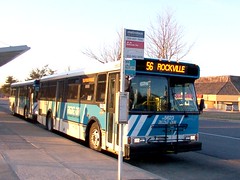 A Ride-On bus in Gaithersburg. Not BRT. |
A report is making the rounds today that claims the Corridor Cities Transitway BRT line could be built for far less money if buses were routed in mixed traffic rather than on a transitway, if “temporary stops” were built instead of stations, and if park and rides were eliminated from the outer stations.
The report is wrong in one very fundamental way: It is impossible to build a bus rapid transit Corridor Cities Transitway for the amount of money they claim.
What *is* possible is to build something so entirely different from the Corridor Cities Transitway that you couldn’t call it the same thing.
It is totally possible to build a non-rapid, non-transitway bus route for a lot less money. And, in doing so, provide a vastly inferior product that would be vastly less convenient, and which would serve vastly fewer passengers.
The report’s authors claim that their redesign wouldn’t slow buses all that much, but they completely miss the point that ride quality also matters. Eliminating stations in favor of normal bus stops and taking away park and rides might not technically slow buses down, but it would certainly affect ridership.
If highway engineers eliminated the exits from an Interstate highway and replaced them with stop lights, the resulting road wouldn’t be an Interstate highway. That’s essentially what is being proposed here. The changes look small on paper, but they add up to big reductions in quality.
|
If highway engineers eliminated the exits from an Interstate highway and replaced them with stop lights, the resulting road wouldn’t be an Interstate highway. |
Montgomery County currently operates about 100 Ride-On bus routes. They could easily add a new Route 101, have it run on existing streets along the Corridor Cities Transitway alignment, and call it a day. Doing that would save a lot of money, but it wouldn’t be providing bus rapid transit.
It’s a bit of a straw man to claim the authors of this report want to go that far, but only a bit. Their proposal would strip the CCT of so many of the amenities that separate it from a normal bus route that functionally, it may as well be one. We’d be left with something that looks a lot like MetroExtra; a little better than local buses, but not BRT.
The real kick to the knees here is that anyone who has followed transit development over the last decade could have predicted this. Stripping BRT projects of their amenities is called BRT creep (and here at GGW), and it happens so often that it’s probably inherent to BRT projects.
The good news is that the Montgomery County Council appears to recognize what a terrible idea this is. Councilwoman Nancy Floreen says “I don’t think we want to do the CCT on the cheap … We want to make this as close to a light rail experience as we can.” Councilman Phil Andrews says the proposal “subjects riders to the same traffic that we want to get them out of.”
But sticking to those guns is going to take a lot of political will, over a long and sustained time. It’s going to take years for the CCT to be built, and this is already the second time the news media has picked up on opponents’ proposal to redefine it as a non-BRT line. Presumably they will continue, and the threat of BRT creep will be with the CCT until the day it opens (and maybe after).
June 21st, 2012 | Permalink
Tags: BRT, bus, transportation













